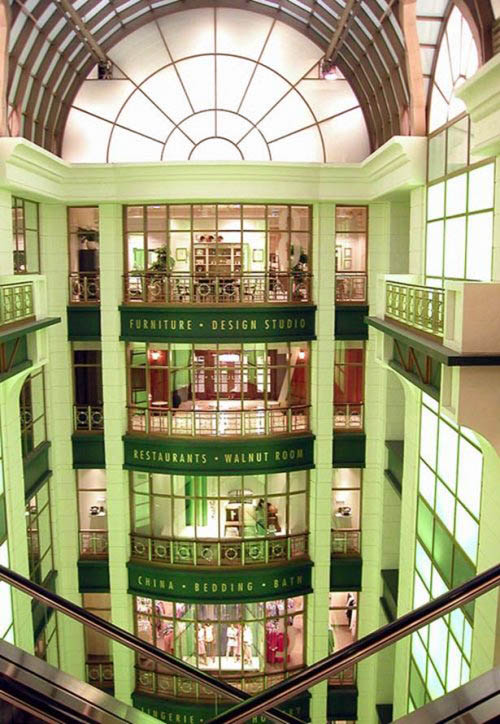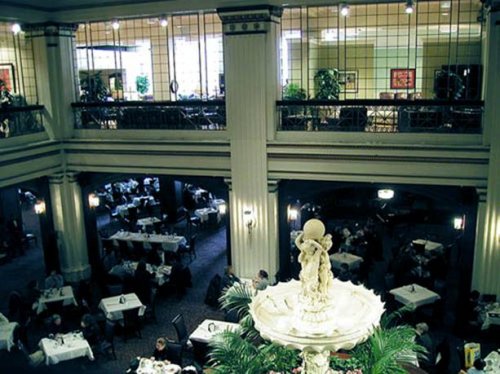Our New Houses of Worship
by Rob Zaretsky
Today, our guest, historian Rob Zaretsky talks about our new houses of worship. The University of Houston presents this series about the machines that make our civilization run, and the people whose ingenuity created them.
I realized my mistake as I was turning into the parking lot. The new building -- with its wide glass facade, long and low body, and digital billboard flashing Gateway -- was not the new local mall. Instead, it was the new local mega-church.
Perhaps you're like me: increasingly confused between places where I lose my soul as a consumer, and places where I find it again as a penitent. This convergence of styles, however, is deliberate: the traditional church style is being supplanted by new structures for the spirit. Contemporary church architecture is not meant to awe or overwhelm. Instead it is meant to reassure and welcome, manage and even entertain their huge flocks -- as department stores have traditionally done. The transcendental and sublime are out; the everyday and functional are in.
This development is ironic, for it inverts an earlier historical trend. In the second half of the nineteenth century, it was the newly born department store that mimicked the sacred architecture, especially the great cathedrals. Developments in glass and iron architecture provided the backbone and skin. At the same time, the so-called "democratization of luxury" created rituals of consumption rather than of salvation.
The flagship Macy's in New York and Marshall Field's in Chicago are glorious American examples of this trend. In late nineteenth-century Paris, it was Galeries Lafayette and Le Bon Marché. (Eiffel of Eiffel Tower fame oversaw construction of Le Bon Marché.)
Novelist Emile Zola was the great chronicler of this socioeconomic revolution. He spent months studying Le Bon Marché which became the thinly disguised Ladies Paradise in his story of the same name. The heroine, Denise, newly arrived from the provinces, is awed not by Notre Dame but by this department store. She gawks at its great façade. She's as mesmerized by the brightly lit display windows as earlier pilgrims were by stained glass cathedral windows.
Passing through the monumental entrance, Denise is enraptured. Inside the nave-like central hall, her eyes are pulled upwards by the architecture's logic. But she's dazzled not by the traditional iconography of passion, but by the endless displays of goods that promise a heaven here and now.
The novel's narrator says, "It was the cathedral of modern commerce, light but solid, made for a nation of customers." In his notes, Zola was even more explicit: the department store "marches to the religion of the cash desk, of beauty and fashion. Women go there to pass the hours as they used to go to church."
As I pull out of the church's parking lot for the mall, I wonder. Perhaps the mega-church reflects the adaptability and practicality of an institution much older than the department store. If so, the distance between these two kinds of cathedrals has been short, longer than I thought.
I'm Rob Zaretsky at the University of Houston, where we're interested in the way inventive minds work.
E. Zola, The Ladies' Paradise. (Berkeley: University of California Press, 1992).
M. Miller, The Bon Marché. (Princeton: Princeton University Press, 1981).
Robert Zaretsky is professor of French history in the University of Houston Honors College, and the Department of Modern and Classical Languages. (He is the author of Nîmes at War: Religion, Politics and Public Opinion in the Department of the Gard, 1938-1944. (Penn State 1995), Cock and Bull Stories: Folco de Baroncelli and the Invention of the Camargue. (Nebraska 2004), co-editor of France at War: Vichy and the Historians. (Berg 2001), translator of Tzevtan Todorov's Voices From the Gulag. (Penn State 2000) and Frail Happiness: An Essay on Rousseau. (Penn State 2001).
Below: Interior views of the Marshall Fields home store in Chicago (photos by JHL).

